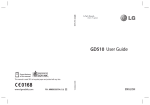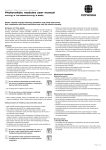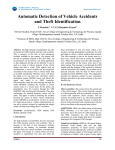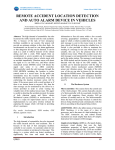Download Installation & User manual
Transcript
Factory Address: No.900 South,Road No.8,PO Box No.1,Sri City SEZ, Sathyavedu Mandal, Chittor Dt,A.P. – 517588 INDIA. www.shansolar.com Index Installation & User manual Series: 3PSS240, 3PSS245 &3MSS245, 3MSS250 Contents 1. Warning Notice 1.1 General Safety 1.2 Handling Safety 2. Mechanical Installation 2.1. Site Selection 2.2. Tilt Angle Selection 2.3. Mounting Installation 2.3.1. 2.3.2. 2.3.3. 2.3.4. General Installation Ground Mounting Roof Mounting Pole Mounting 3. Electrical Insulation 3.1. Grounding Method 3.2. General Installation 4. Maintenance 5. Module Specifications 6. Disclaimer of Liability. Warning Notice 1. WARNING Hazardous electricity! 1.1 WARNING 1. Photovoltaic modules can generate electricity upon exposure to light. The voltage of a single module is less than 45VDC, but the shock hazard increases as modules are connected in parallel producing higher current. The shock hazard increases as modules are connected in series producing higher voltages. 2. All instructions should be read and understood before attempting to install, wire, operate, and maintain the photovoltaic module. Contact with electrically active parts of the module such as terminals can result in burns, sparks, and lethal shock whether the module is connected or disconnected. 3. Do not disconnect the connector of the modules while under load. To achieve disconnect while under load, a provision of High Voltage Slow Blow DC Fuse or High Voltage DC MCB should be provided in the Array Junction Box. 1.2 CAUTION 1. To avoid the hazard of electric shock and injury, cover the entire front surface of the PV modules with a dense, opaque material such as a cardboard sheet, during installation and handling of the modules. 2. Do not hit or put excessive loads on the glass or back sheet or twist the frame; the glass may break/ PV cells may break. 3. Do not stand or step on the PV module; the glass may be slippery and there is a risk of injury or electric shock if glass breaks. 4. PV modules are heavy, please handle with care. Do not drop or allow objects to fall on the PV module. 5. Do not twist the interconnect cable excessively. 6. Unauthorized persons, except the qualified licensed professional, should not open the cover of the junction box to avoid the hazard of electric shock. Provide suitable guards to prevent yourself from direct contact with 30 VDC or greater to avoid the hazard of electric shock or injury. 7. When carrying a module, two or more people should carry it by its frame and wear non-slip gloves (to avoid injury by a slipping module, to a foot, or cuts by the edge of a frame, and so on). 8. Do not lift the modules by grasping the module junction box or electrical cables. 1.2 Installation Safety: WARNING All PV modules shall be installed in accordance with applicable codes and regulations, including but not limited in USA to National Electrical Code (NEC) and in Canada in accordance with CSA C22.1, Safety standard for electric installation, Canadian electrical Code (CEC). CAUTION 1. Only PV modules with the same cell type and size should be connected in series. 2. Follow all safety instructions of other components used in the system. 3. Avoid uneven shade on the PV module surface .Shaded cells may become hot (hot spot phenomenon) which may result in permanent damage to the module. 4. Do not drill holes in the frame, it may compromise the frame strength and cause Corrosion of the frame also voids the warranty. 5. To avoid the hazard of electric shock, work only under dry conditions, with dry Modules and tools. 6. Do not puncture or damage the back-sheet of a module, to avoid the hazard of Electric shock and fire. 7. To avoid the hazard of electric shock and injury, be sure to completely ground all Modules & do not disassemble the module, or remove any part installed by the manufacturer . 8. Since sparks may occur, do not install the module where flammable gases or vapors are present. 9. Never leave a module unsupported or unsecured. 10. Do not use mirrors or other magnification device to artificially concentrate sunlight onto the modules. 11. Do not change the connection of bypass diodes to avoid the hazard of electric shock and injury. 12. SS series of modules qualified for Application class A. 2.0 MECHANICAL INSTALLATION 2.1 Site Selection: 1. PV modules are intended for outdoor use only and should be installed in a location Where they will receive maximum sunlight throughout the year. 2. In Northern latitudes, the modules would normally face true south & in the Southern Latitudes, the modules should face north for optimum power output. 3. Avoid trees, buildings or obstructions which could cast shadows on the solar modules especially during the winter months when the arc of the sun is lowest over the horizon. 4. Solar modules produce maximum power when they are pointed directly at the sun. 5. For installations where the solar modules are mounted to a permanent structure, the solar modules should be tilted for optimum winter performance. 2.2 Tilt Angle Selection: More sunlight per square fur falls on a perpendicular surface (90 deg to the suns ray is optimal).Less sunlight falls on a vertical surface & horizontal surface. The module tilt angle is measured between the solar modules and the ground Tilt angle Table: Site Latitude in Degree 0° to 15° 15° to 25° 25° to 30° 30° to 35° 35° to 40° 40° Fixed tilt angle 15° Same as latitude Latitude + 5° Latitude + 5° Latitude + 5° Latitude + 5° Sun Arc Table: Latitude 10° 15° 20° 25° 30° 35° 40° 45° Summer 12.71° 13.02° 13.34° 13.7° 14.08° 14.54° 15.02° 16.62° Winter 11.54° 11.24° 10.92° 10.58° 10.21° 9.80° 9.33° 8.76° 2.3 Mounting Installation: 2.3.1 General Installation 1. Place the modules on top of the structure & mount it by using the pre-drilled round mounting holes as shown below & fix it firmly on the structure using the mounting hardware`s (M8 nuts & Bolts). 2. Always select the length of mounting screw after considering a clearance of 5-10 mm between the module back face & screw face to avoid any breakage of module while tightening (as shown below). 3. The support module mounting structure must be made of durable, corrosion resistant and UV resistant material. 4. Modules should be firmly fixed in place in a manner suitable to withstand all expected loads, including wind & snow loads. Determine wind loads for the installation site & consult it from safety departments for the specific requirements. 5. All hardware like bolts, nuts & washers should be of stainless steel so as to eliminate the possibility of rust. 6. The Open circuit Voltage exceeds the rated voltage. Take care that the open circuit voltage multiplied by the number of modules in series is not higher than the Max. System voltage (IEC-1000V/ UL 600V). 7. Module mounting must use the pre-drilled mounting holes in the frame. 8. Do not drill additional mounting holes on the frame & glass surface of the module. Doing so will void the warranty. 9. Earthing: Use earthing the cable with ring tong terminals & connect the cable at modules mounting holes. 2.3.2 Ground Mount 1. Select the lowest height of the structure to prevent the lowest height of the module from being covered by snow for a long time in winter. 2. In addition ensure that the lowest portion of the module is placed high enough so that it is not shaded by trees or plants and not damaged by sand or stone driven by wind. 3. The supporting frame/structure is used to mount modules at correct tilt angles. 4. Clearance between the modules frame & the mounting surface is required to prevent the junction box from touching the surface & to allow cooling air to circulate around the back of the module. This also allows any condensation or moisture to dissipate. 3 Electrical Insulation 3.1. Grounding Method 1. The module frame must be properly grounded to avoid the hazards of electric shock or fire. 2. PV array frame is ground in accordance with NEC Article 250 (USA) or CEC (Canada) 3. Each framed module has two mounting holes for mounting the module on the structure. The same holes are used for connecting grounding conductor to the module metal frame as shown below. The grounding will be provided by fixing earthing cable with Hex Nut, Star Tooth Washer ,Flat Washer and Hex Head Bolt as shown in the below picture. 4. The entire metal frame is grounded. 5. "All the above mentioned grounding hardware should be of stainless steel to prevent corrosion. Recommended 6. Torque 1.2 - 1.8 Nm." If functional grounding is used (i.e. grounding plus of minus), such grounding means should be isolated from live parts by reinforced insulation. 3.2 General Installation 1. Do not use modules of different configuration in the same system. 2. This module is supplied with multi contact connectors for electrical connections. 3. Refer to section 690.31 of the NEC to determine appropriate types and temperature ratings of conductors. Wiring should be #12 AWG, 4 m (minimum) and must be temperature rated at 90°C (minimum). 4. Completely cover system modules with an opaque material to prevent electricity from being generated while disconnecting conductors. 5. Refer to sections 690.8 and 310 of the NEC to determine over current, conductor ampacity and size requirements. 6. In Canada, installation shall be in accordance with CSA C22.1, Safety Standard for Electrical Installation, Canadian Electrical Code, Part 1. 7. For best performance, ensure that positive and negative DC wires run closely together avoiding loops. 4. Maintenance SHAN SOLAR recommends the following maintenance items to ensure optimum performance of the module: 1. Annual inspection of the PV modules, array, and BOS is highly recommended. The following items (regarding the PV modules) should be checked periodically to keep the PV system functioning correctly for many years. 2. Ensure there is no corrosion on any mechanical connection between the PV module and the mounting structure. Tighten all loose components to specified torque settings. 3. Check all electrical connection for corrosion and separation on PV modules (connectors, cables, and grounds). 4. Never disconnect PV modules under load! 5. Make sure PV modules are clean and free of dirt and dust use water and a soft sponge or cloth for cleaning. A mild, non cleaning agent can be used if necessary. 6. 7. 8. 9. Critical Cleaning Liquid Detergent is recommended. Do not use dishwasher detergent! Use water pressure of 45 PSI (3 bar) or less. De-ionized water is recommended if available. Do not use cold water on hot modules 5. Product specification:- Properties Maximum Power (Pmpp) Rated Voltage (Vmpp) Rated Current (Impp) Open Circuit Voltage (Voc) Short Circuit Current (Isc) Maximum System Voltage Maximum Series Fuse Rating Fire Class 3MSS60 245 3MSS60 3PSS60 3PSS60 250 240 245 245 31.21V 7.85A 250 30.64V 8.17A 240 245 30.09V 30.32V 7.99A 8.1A 37.63V 37.23V 37.25V 37.65V 8.42A 8.74A 8.61A 8.61A 1000 V 1000 V 1000 V 1000 V 17 A C 17 A C 17 A C 17 A C 6. Disclaimer of Liability. 1. Because the use of this manual and the conditions or methods of installation, operation, use and maintenance of photovoltaic products are beyond SHAN SOLAR PVT. LTD. Control, SHAN SOLAR PVT.LTD. Does not accept responsibility and expressly disclaims liability for loss, damage, or expense arising out of or in any way connected with such installation, operation, use and maintenance. No responsibility is assumed by SHAN SOLAR PVT. LTD. for any infringement of patents or Other rights of third parties, which may result from use of the PV product. No license is granted by implication or otherwise any patent or patent rights. 2. The information in this manual is based on SHAN SOLAR PVT. LTD. knowledge and experience and is believed to be reliable, but such information including product specification (without limitations) and suggestions does not constitute a warranty, expressed or implied. SHAN SOLAR PVT. LTD. Reserves the right to change the manual, the product, the specifications, or product information sheets without prior notice. Shan Solar Pvt. Ltd. No.900 South, Rd No.8, PO Box No.1, Sri City SEZ, Sathyavedu Mandal ,Chittoor Dt A.P. Pin -517588 (INDIA)


















